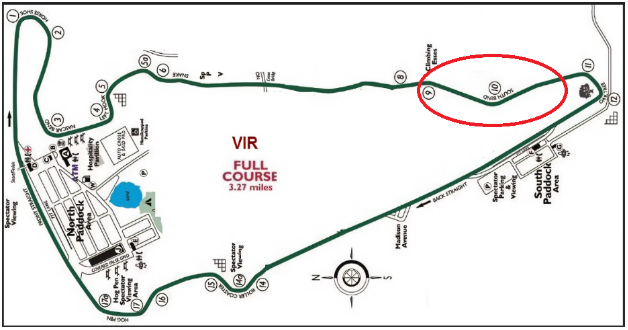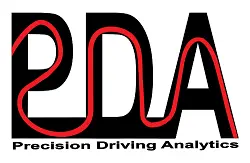Why It Is Important To Prioritize Corners
Racing Corners and Why They Should be a Priority
In order to get the fastest lap time, you need to figure out what racing corners are more important than others. This is especially true if one corner directly leads into another corner. The SCCA Runoffs were held last fall at Virginia International Raceway (VIR) and I was supporting several different drivers for one of my customers. There are certain parts of VIR where knowing which corners to prioritize pays big dividends in lap times. One of these areas is the Turn 9 and Turn 10 complex. Turn 10 (South Bend) is one of the fastest corners and it is tricky to get right. But getting it right is also dependent on how the driver exits Turn 9. The section of the track that I’m referring to is circled in red in the map below.

Most cars can be at full throttle through the Climbing Esses and Turn 9 is at the top of those esses. However, most cars cannot take Turn 9 at 100% throttle and still get the car setup for Turn 10. So which corner should be the priority, Turn 9 or Turn 10?
One of the drivers that I was working with was really intent on taking T9 faster because he saw other drivers doing it. The problem was that most times he took Turn 9 faster, he ended up being slower through Turn 10. I knew this was hurting his lap time so I needed to convince him that Turn 10 should be the priority. How did I do that? I came up with some metrics using the data.
The first thing that I looked at was the time spent in Turn 9 versus Turn 10. He could not take Turn 9 at 100% throttle and he had to brake for Turn 10. On his fastest qualifying lap, from the point where he lifted for Turn 9 to the point that he braked for Turn 10 was 3.78 seconds and 647 ft. The average speed was 170.26 ft/sec or 116.09 mph. From the point that he braked for Turn 10 to the point that he braked for Turn 11 was 8.01 sec and 1,126.6 ft. Therefore, his average speed was 140.65 ft/sec or 95.89 mph.
He was faster through the Turn 9 and Turn 10 complex on another lap. The time that it took him to get through Turn 9 (again the point of his lift for Turn 9 to the point we braked for Turn 10) was 3.54 sec (.24 sec faster) and the distance was 600.4 ft. His average speed was 169.60 ft/sec or 115.64 mph (.45 mph slower). The amount of time that it took him to get through Turn 10 was 7.75 sec (.26 sec faster) and the distance between the point that he braked for Turn 10 to the point that he braked for Turn 11 was 1,120.7 feet. His average speed was 144.52 ft/sec or 98.54 mph (2.65 mph faster). See the chart below for a summary of the two laps along with the variances.


As you can see, even though he was slightly slower through Turn 9, he also drove a slightly less distance and this gained him .24 seconds. On top of that, he gained another .26 seconds so the net gain was .5 sec!
The videos below show the point at which the driver braked for Turn 10. On his fastest lap, he didn’t use all of the track that was available on the right or another way to put it is that he didn’t open the radius. His speed was 111 mph at this point on both laps.


By opening the radius more for Turn 10 on the faster segment lap, he was able to increase his Turn 10 minimum speed by 2 mph – 91 mph on his fastest segment lap and 89 mph on his fastest lap!


The driver benefited from this extra speed all the way to the braking for T11.
The one thing that the driver had to do a little differently was turn in a little later for Turn 9 so that he would end up on the right side of the track when he hit the brakes for Turn 10. But by recognizing that prioritizing Turn 10 would pay bigger dividends in lap time, he knew that this was the correct approach. As a result, he ended up turning even faster lap times in later sessions.
